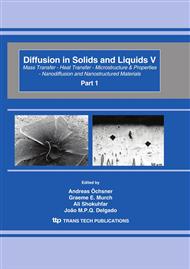p.602
p.608
p.618
p.624
p.631
p.641
p.650
p.656
p.664
Diffusion of Hydrogen in Single Crystals of Monoclinic-ZrO2 and Yttrium Stabilized Cubic Zirconia
Abstract:
Transport of hydrogen through oxide layers formed on zirconium alloys has been the focus of studies associated with hydrogen ingress into nuclear reactor core components. The studies have shown that microstructure and microchemistry of the underlying alloy can affect the characteristics of the oxide and in turn the transport of hydrogen through the oxide and into the underlying metal. In certain cases the oxide layer can be a homogeneous medium for hydrogen diffusion, while in most cases it is found to be heterogeneous and comprised of homogeneous, nonporous and fully oxidized, cells surrounded by a network of fast diffusion paths for hydrogen. Since in such heterogeneous systems the derived diffusion parameter and the cell size are interdependent, an absolute diffusion parameter could only be derived if the cell size were known. However, no such information is available from the microstructural studies on the oxides grown on these alloys. Another alternative is to carry out the measurements in a material, which is homogeneous at least within the dimensions of a few μm - the range of the measurements. With this in mind, hydrogen diffusion measurements were carried out in a set of single crystal zirconia specimens with the prospect that the single crystals would provide a non-porous and homogeneous medium to study the diffusivity of hydrogen. These measurements show that the single crystal specimens, contrary to the initial thinking, are not entirely homogeneous and the results do not yield an absolute diffusion coefficient for hydrogen in zirconium oxides. The details and analyses of the results from the single crystal zirconia specimens are discussed in this paper.
Info:
Periodical:
Pages:
631-640
Citation:
Online since:
April 2010
Authors:
Keywords:
Price:
Сopyright:
© 2010 Trans Tech Publications Ltd. All Rights Reserved
Share:
Citation:


